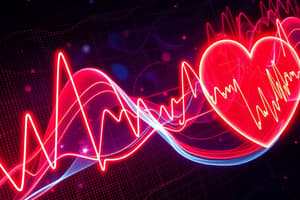Podcast
Questions and Answers
What is the heart rate range classified as normal sinus rhythm?
What is the heart rate range classified as normal sinus rhythm?
- 60-100 BPM (correct)
- 50-75 BPM
- 55-85 BPM
- 70-110 BPM
What is the recommended treatment for symptomatic sinus bradycardia?
What is the recommended treatment for symptomatic sinus bradycardia?
- Defibrillation
- Pacemaker or atropine (correct)
- Cardioversion
- Oral anticoagulants
In which condition is the heart rate generally between 350 and 600 BPM?
In which condition is the heart rate generally between 350 and 600 BPM?
- Ventricular Fibrillation
- Atrial Flutter
- Sinus Tachycardia
- Atrial Fibrillation (correct)
Which arrhythmia features a 'sawtooth' appearance on an EKG?
Which arrhythmia features a 'sawtooth' appearance on an EKG?
What is the immediate action indicated for ventricular fibrillation?
What is the immediate action indicated for ventricular fibrillation?
What is the primary concern of atrial fibrillation that necessitates anticoagulation?
What is the primary concern of atrial fibrillation that necessitates anticoagulation?
Sinus tachycardia is defined as a heart rate of over 100 BPM.
Sinus tachycardia is defined as a heart rate of over 100 BPM.
What is the treatment for ventricular fibrillation?
What is the treatment for ventricular fibrillation?
Atrial flutter typically presents with a __________ appearance on an EKG.
Atrial flutter typically presents with a __________ appearance on an EKG.
Match the arrhythmias with their respective heart rate ranges:
Match the arrhythmias with their respective heart rate ranges:
Flashcards are hidden until you start studying
Study Notes
Normal Sinus Rhythm
- Heart rate between 60-100 BPM indicates a normal sinus rhythm.
Sinus Bradycardia
- Defined as a heart rate of less than 60 BPM.
- Symptomatic patients may require treatment; asymptomatic patients typically do not.
- Treatment options include atropine to increase heart rate or placement of a pacemaker.
Sinus Tachycardia
- Characterized by a heart rate exceeding 100 BPM.
- Treatment focuses on identifying and addressing the underlying cause, such as fever, hypotension, pain, or anxiety.
Atrial Fibrillation
- Rapid atrial rhythm with heart rates ranging from 350-600 BPM.
- Treatment includes cardioversion or antiarrhythmics.
- Anticoagulation therapy is essential to prevent thromboembolism and reduce stroke risk.
Atrial Flutter
- Heart rate between 250-400 BPM.
- Notable for its "sawtooth" appearance on EKG.
- Management involves cardioversion or antiarrhythmics to restore normal rhythm.
Ventricular Fibrillation
- Heart rate cannot be determined; EKG shows chaotic waves.
- Immediate treatment requires CPR followed by defibrillation to restore a pulse.
- Activation of emergency response (code blue) is necessary.
Normal Sinus Rhythm
- Heart rate between 60-100 BPM indicates a normal sinus rhythm.
Sinus Bradycardia
- Defined as a heart rate of less than 60 BPM.
- Symptomatic patients may require treatment; asymptomatic patients typically do not.
- Treatment options include atropine to increase heart rate or placement of a pacemaker.
Sinus Tachycardia
- Characterized by a heart rate exceeding 100 BPM.
- Treatment focuses on identifying and addressing the underlying cause, such as fever, hypotension, pain, or anxiety.
Atrial Fibrillation
- Rapid atrial rhythm with heart rates ranging from 350-600 BPM.
- Treatment includes cardioversion or antiarrhythmics.
- Anticoagulation therapy is essential to prevent thromboembolism and reduce stroke risk.
Atrial Flutter
- Heart rate between 250-400 BPM.
- Notable for its "sawtooth" appearance on EKG.
- Management involves cardioversion or antiarrhythmics to restore normal rhythm.
Ventricular Fibrillation
- Heart rate cannot be determined; EKG shows chaotic waves.
- Immediate treatment requires CPR followed by defibrillation to restore a pulse.
- Activation of emergency response (code blue) is necessary.
Studying That Suits You
Use AI to generate personalized quizzes and flashcards to suit your learning preferences.




